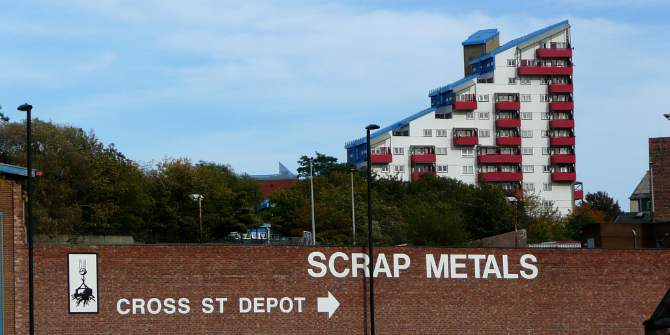In Justice and Fairness in the City: A Multidisciplinary Approach to ‘Ordinary’ Cities, editors Simin Davoudi and Derek Bell present a collection that explores notions of justice in and of the city, with particular focus upon the case of Newcastle. Traversing a range of themes, including questions of mobility, food poverty, education and green space, this cohesive volume underscores the interwoven sites and spaces of inequality experienced within contemporary cities, finds Paulo Rui Anciaes.
Justice and Fairness in the City: A Multidisciplinary Approach to ‘Ordinary’ Cities. Simin Davoudi and Derek Bell (eds). Policy Press. 2016.
 Justice and fairness are not easy to define. In the foreword to Justice and Fairness in the City: A Multidisciplinary Approach to ‘Ordinary’ Cities, the chair of the Newcastle Fairness Commission is glad that the task of developing principles of justice to inform resource allocation in the city of Newcastle was completed ‘before anyone could point out that it was impossible’ (xiv). The aim of this edited book is to continue the work of that commission by exploring injustices in Newcastle from a range of perspectives, each of them highlighting different injustices experienced by different people.
Justice and fairness are not easy to define. In the foreword to Justice and Fairness in the City: A Multidisciplinary Approach to ‘Ordinary’ Cities, the chair of the Newcastle Fairness Commission is glad that the task of developing principles of justice to inform resource allocation in the city of Newcastle was completed ‘before anyone could point out that it was impossible’ (xiv). The aim of this edited book is to continue the work of that commission by exploring injustices in Newcastle from a range of perspectives, each of them highlighting different injustices experienced by different people.
Throughout the book there is an emphasis on Newcastle as an ‘ordinary city’. The meaning of this concept and, most of all, its usefulness are not very clear. I got the impression that by ‘ordinary cities’, the authors simply mean all the cities in the world apart from four or five big ‘world cities’. The editors, Simin Davoudi and Derek Bell, explain that the justice issues found in ‘ordinary cities’ like Newcastle are relevant for all cities, but at the same time admit that ‘the city’ is a plural phenomenon, while the introductions of many chapters go to great lengths to emphasise the characteristics that set Newcastle apart.
Nevertheless, this book makes two important contributions to our understanding of justice and fairness, developing concepts that apply to all cities (‘ordinary’ or not) and, in most cases, also to non-urban contexts.
The first contribution is to provide guidelines for translating empirical claims relating to inequality into moral claims that those inequalities are unjust. This is done, for example, by looking at a variety of ‘objects of distribution’, such as mobility, green space, food and education, which are not explicitly considered by political liberalists who otherwise tend to focus on income and wealth. Injustices emerge in the relationships among inequalities in the distribution of different objects. For example, low-income communities may have low access to green spaces and at the same time be affected by environmental issues such as litter (Chapter Two); or they may have poor access to both car ownership and public transport and in addition be more exposed to transport-related air pollution (Chapter Four). The political relevance of inequalities also depends on who experiences them and how, something that changes throughout the life course. Thus, the importance of providing access to social networks for older people (Chapter Eleven), good education for children (Chapter Twelve) and fair pay for people of working age (Chapter Thirteen)
Claims about injustice also require going beyond matters of distribution to look at fairness in processes and procedures. More broadly, justice is about the recognition of all citizens as moral equals, while acknowledging differences between groups: a position close to multiculturalism. For example, Chapters Two and Four show that identities and vulnerabilities linked to gender, race and class affect access to green spaces and transport. Chapter Six also alerts us to the tendency for denying the differences of Traveller communities and young subcultures, especially when those differences get in the way of the suburban middle classes and new retail developments.
 Image Credit: (Metro Centric CC BY 2.0)
Image Credit: (Metro Centric CC BY 2.0)
The second contribution of the book is to consolidate the view that the city is not only a physical space where injustices occur (‘justice in the city’) but also a social and cultural space that produces injustices (‘justice of the city’) – although, for some reason, the title of the book only mentions the first of these concepts. ‘Justice of the city’ is discussed mainly in terms of the rights of individuals to access urban life and to participate in the creation of the city. This is where the book becomes dense and jargon-heavy (‘spatiotemporal patterns of practices’; ‘disjuncture between perceptions’; ‘despoiled places’). Nevertheless, Chapters Seven and Eight are fascinating accounts of the contradictions between the rights of young people to use and construct space and the priorities of city authorities for redesigning and rebranding the city to satisfy consumers and corporate interests.
Despite the intention of looking at injustices from different perspectives, in fact almost all the chapters were written by geographers and planners and rely on qualitative information. Granted, it is difficult to use numbers or maps to assess procedural justice or nebulous concepts such as ‘recognition’ or, more generally, to compare inequalities between the experiences of different people. But quantitative data could have been used as a starting point to a broader analysis of the justice implications of empirical patterns of inequality. This is done very effectively in the chapter on green space, but other chapters where this approach would be useful (for example, the ones on food justice and transport) are mainly literature reviews and provide insufficient information about the case study.
The range of inequalities analysed is also narrower than it could be. The very first paragraph of the book talks about ‘radical’ inequalities in wealth, housing, social capital, access to services and treatment by authorities, but the rest of the book does not reflect on the situation of the citizens who lack (or are denied by governments) access to even a basic provision of those resources and services. Homelessness is only mentioned when describing the processes leading to the concentration in a single neighbourhood of a disproportionate share of flats for households facing homelessness.
It is also difficult to assess inequalities as injustices without investigating the causes of those inequalities. Yet the economic forces behind urban development, neighbourhood regeneration and gentrification are only briefly covered in a chapter comparing Newcastle with Delhi (Chapter Six). To compensate, in Chapter Ten we get a very interesting account of how political commitments to justice do not necessarily translate into actual justice-promoting administrative practices, with the Marxist-like conclusion that the idealism of political liberalism fails to take into account the power relationships produced by the economic and political history of the city. In the end, the most promising methods to promote justice are probably the actions of local communities challenging what they perceive as unjust, such as initiatives to tackle food poverty (Chapter Five) and to recreate the outdoor space of schools as environmental resources for the local community (Chapter Three).
The editors nonetheless have done a great job in assembling the contributions of 25 authors. The book is very cohesive, with a handful of themes flowing seamlessly throughout the text and with explicit links between chapters. The discussions on ‘justice for the city’ consistently use the same framework drawn from the work of David Harvey and Henri Lefebvre. The conclusions also perfectly sum up the lessons learnt and open up to future research.
Justice and Fairness in the City ends on a positive note, with calls for understanding justice as ‘recognition’ in relation to the national and the global scales (‘justice for’ and ‘justice by’ the city). This is unfortunately a quixotic quest, at a time when politicians are becoming unashamedly parochial and the powerful are increasingly loud and perverse when telling the most vulnerable that they do not have any right to the city, using methods such as ‘racist vans’ and ‘anti-homeless spikes’. Maybe reading books like Justice and Fairness in the City could help policymakers regain the sense of reason and humanity that is needed to address social injustices.
Paulo Rui Anciaes is a researcher at the Centre for Transport Studies, University College London. He completed his PhD. at the Department of Geography and Environment of the London School of Economics. Paulo blogs about Community Severance and Alternative Environmentalism and contributes to the UCL Street Mobility project blog.
Note: This review gives the views of the author, and not the position of the LSE Review of Books blog, or of the London School of Economics.







